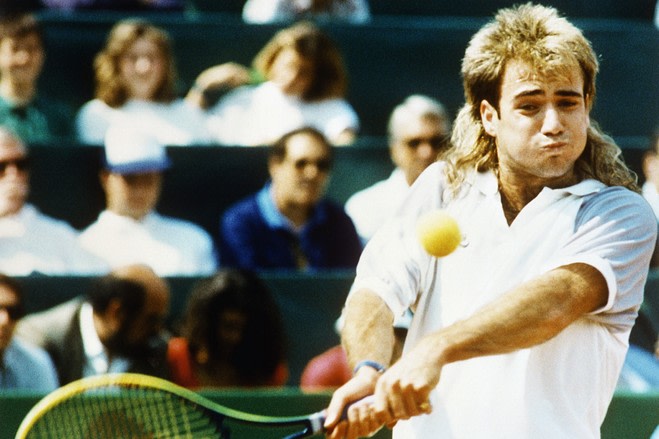How to Lick a Killer Serve

In a tennis match, each point starts the same way: a serve. One of the players stands behind the baseline — that’s the far white line that runs parallel to the net — and tosses the ball upward. He or she then strikes the ball with the racket, hoping to drive the ball into the box diagonally across the court and on the other side of the net. If the server succeeds, the opponent now has to return the serve by hitting the ball back over the next — but that is often easier said than done. Professional tennis players can hit serves that reach 150 miles per hour (240 kph) and with control. If you are returning a serve like that, you have a problem: the ball is coming toward you very quickly, but you don’t really know where it’s going. How are you supposed to hit it?
That was the problem Andre Agassi, above, had in 1989. That November, the 19-year-old phenom was ranked 6th in the world when he entered the Nabisco Masters, a tournament held at New York’s Madison Square Garden. Agassi’s ranking, though, didn’t make him a favorite in the tourney — far from it. The Masters (now called the ATP Finals) featured eight of the top players in the world, and he fared poorly, losing all three of his matches. Of particular note was his match against Boris Becker, then the world’s #2. Becker, who had just turned 23 a few days prior to their match, beat Agassi easily, ceding only four games out of the 16 in their match. It was the third time Becker and Agassi had faced each other, and the third time Becker had come out on top.
It was the second-to-last time that would happen. Over the course of their careers, Agassi and Becker met 11 more times. Agassi won ten of those matches.
The solution? Becker’s tongue.
Becker’s serve was his best weapon on the court. While serves reaching and exceeding 130 mph (210 kph) are not uncommon today, they were rare at the time, and Becker could consistently hit that speed. Further, Becker didn’t gain speed at the cost of accuracy — he could consistently control where it went, directing his serve down the center of the court or sending it wide. Agassi himself would describe Becker’s serve as “something the game had never seen before,” making Becker very difficult to beat. After losing to Becker in the Nabisco Masters, Agassi realized he needed to find a way to hit Becker’s serve, so he did what most good athletes do: they watch video replays of matches. And after a while, Agassi noticed something subtle. He explained his discovery to The Players’ Tribune:
I started to realize he had this weird tick with his tongue. [ . . . ] Just before he would toss the ball, he would stick his tongue out, and it would either be right in the middle of his lip or it would be to the left corner of his lip. So if he’s serving in the deuce court [that’s the right side of the court], and he put his tongue in the middle of his lip, he was either serving up the middle or to the [opponent’s] body. But if he put it to the side, he was going to serve out wide.”
The little flick of the tongue was something very hard to see, and you don’t have to take my word for it. A few years after Agassi’s sit-down with The Players’ Tribune, Tennis TV spliced the interview with some game footage of Becker’s, seen here, and you can see what Agassi was referring to. Becker’s tongue motion was a quick one and Agassi would have to pick up on it from a distance and at an angle, so it required a lot of focus if Agassi wanted to use the information consistently. But as Agassi further explained, that may have been a good problem to have: “The hardest part wasn’t returning his serve; the hardest part was not letting him know that I knew this. So I had to resist the temptation of reading his serve for the majority of the match and choose the moment when I was going to use that information on a given point to execute a shot that would allow me to break the match open.”
But Agassi did, ultimately, let Becker know what he had discovered (after Boris had retired, of course). Becker’s reaction, per Agassi? “I used to go home all the time and tell my wife, ‘it’s like he reads my mind!’ Little did I know you were just reading my tongue.”
Bonus fact: Agassi was great on the court and probably enjoyed solving the mystery of Becker’s serve, but there’s good reason to think he didn’t actually like playing tennis. The best evidence of this? His 2009 memoir, “Open.” In the third paragraph of the book, excerpted by NPR here, Agassi talks about waking up on the day of his last-ever tournament, the 2006 U.S. Open. He ends the paragraph with an uncommon admission for an athlete: “I play tennis for a living, even though I hate tennis, hate it with a dark and secret passion, and always have.”
From the Archives: All You Need is Egg: Why “love” means “nothing” in tennis.
